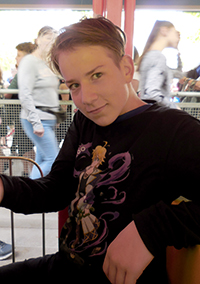 Gideon T. Haug. Ludwig-Maximilians-Universität München, Biocenter, Großhaderner Str. 2, 82152 Planegg-Martinsried, Germany. gideon.haug@palaeo-evo-devo.info
Gideon T. Haug. Ludwig-Maximilians-Universität München, Biocenter, Großhaderner Str. 2, 82152 Planegg-Martinsried, Germany. gideon.haug@palaeo-evo-devo.info
Gideon T. Haug is a high-school student, but became interested in biology due to the work of his parents and travelling with them to museum collections. He did first smaller projects when his parents were working at the Yale Peabody Museum, New Haven. He presented his first achievements on a German conference in 2012 when the Haug family was based at the University of Greifswald. Since the family moved to the Ludwig-Maximilians-Universität München (LMU Munich) in autumn 2013, he presented further posters on various zoological and palaeontological conferences. Gideon gave his first oral presentation on his work on lacewing larvae in autumn 2019 and co-authored the first paper in 2020. He is skilled in digital microscopy, image processing, digital drawing and 3D modelling. So far he has worked on extant larvae of mantis shrimps and different fossil insects and shrimps.

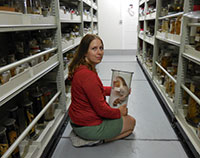 Carolin Haug. Ludwig-Maximilians-Universität München, Biocenter, Großhaderner Str. 2, 82152 Planegg-Martinsried, Germany and GeoBio-Center at LMU, Richard-Wagner-Str. 10, 80333 München, Germany. carolin.haug@palaeo-evo-devo.info
Carolin Haug. Ludwig-Maximilians-Universität München, Biocenter, Großhaderner Str. 2, 82152 Planegg-Martinsried, Germany and GeoBio-Center at LMU, Richard-Wagner-Str. 10, 80333 München, Germany. carolin.haug@palaeo-evo-devo.info
Carolin Haug studied biology at the Julius-Maximilians-Universität Würzburg with animal ecology as major subject and sociobiology and palaeontology as minor subjects. She received her Diplom in 2005 and moved to the University of Ulm for her Ph.D. thesis. In the work group Biosystematic Documentation she investigated the ontogeny and evolution of the arthropod head shield on a wide spectrum of fossil and extant specimens. Due to the very different demands of the material, she developed new imaging techniques or modified existing methods together with her collaborators, for example, composite imaging, stereo photography or autofluorescence macro- and microscopy. In 2011, Carolin defended her Ph.D. thesis. She was a postdoctoral researcher at Yale University and at the Ernst-Moritz-Arndt-Universität Greifswald. Besides optimising imaging techniques, she is interested in fossilised development (see also http://www.palaeo-evo-devo.info) and in the evolution of tagmosis. For this purpose, she investigates mainly arthropods from different deposits yielding exceptional preservation, such as Rhynie chert, Solnhofen Lithographic Limestones, the 'Orsten', Burgess Shale, or Mazon Creek, always in comparison to their extant relatives. Carolin moved to Munich in 2013 to continue her research there at the Ludwig-Maximilians-Universität.

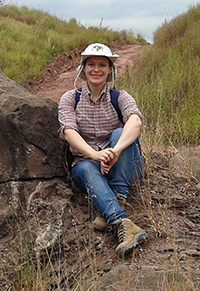 Paula G. Pazinato. Ludwig-Maximilians-Universität München, Biocenter, Großhaderner Str. 2, 82152 Planegg-Martinsried, Germany. paula.pazinato@palaeo-evo-devo.info
Paula G. Pazinato. Ludwig-Maximilians-Universität München, Biocenter, Großhaderner Str. 2, 82152 Planegg-Martinsried, Germany. paula.pazinato@palaeo-evo-devo.info
Paula G. Pazinato is from Abelardo Luz, southern Brazil. She studied Social Communication (Bachelor) at UNISINUS, Palhoça, and Biological Sciences (Bachelor) at Federal University of Pelotas, Pelotas. Then she moved to Rio Claro, São Paulo, to study Geosciences and Environmental Sciences, where she got a Master of Science degree with a CNPq scholarship. Since 2018 she is a PhD candidate with a CAPES Scholarship at the Zoomorphology Group at Ludwig-Maximilians-Universität München, under the supervision of Joachim T. Haug. She develops research in systematics and evolution of fossil crustaceans, specially peracaridans and, eventually, insects.

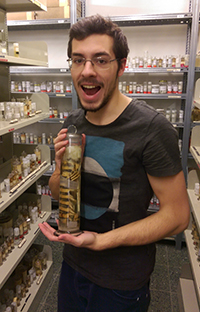 Florian Braig. Ludwig-Maximilians-Universität München, Biocenter, Großhaderner Str. 2, 82152 Planegg-Martinsried, Germany. florianbraig@t-online.de
Florian Braig. Ludwig-Maximilians-Universität München, Biocenter, Großhaderner Str. 2, 82152 Planegg-Martinsried, Germany. florianbraig@t-online.de
Florian Braig was born in Schleswig, Germany in 1996. He studied biology and successfully achieved the degree Bachelor of Science at Ludwig-Maximilians-Universität München (LMU Munich). In 2018, he continued at the same institute studying Evolution, Ecology and Systematics to achieve the degree Master of Science. He has so far worked on different extant and fossil predatory representatives of Euarthropoda, including mantis shrimps, thylacocephalan crustaceans, and lacewing larvae. Currently, his research focus is on the ecology and morphology of mantis shrimp larvae.

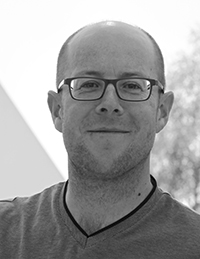 Vincent Perrichot. Univ. Rennes, CNRS, Géosciences Rennes, UMR 6118 35000 Rennes, France. vincent.perrichot@univ-rennes1.fr
Vincent Perrichot. Univ. Rennes, CNRS, Géosciences Rennes, UMR 6118 35000 Rennes, France. vincent.perrichot@univ-rennes1.fr
Vincent Perrichot is born in Brittany, France in 1976. He obtained his Ph.D. in biology at the University of Rennes in 2003, on the study of Cretaceous amber deposits from France and their corresponding forest ecosystems. He spent two years at the Natural History Museum of Berlin as a Humboldt research fellow, working with Alexander Schmidt on the paleoecology of resin-producing forests through the study of arthropods and microorganisms fossilized in amber. He then became a postdoctoral fellow at the Paleontological Institute of the University of Kansas, where he worked on the systematics, phylogeny, and biogeography of hymenopteran insects from various Mesozoic and Cenozoic ambers. In 2009 he returned to the University of Rennes as a full time assistant professor. Since then he has been studying the paleobiota and paleoenvironments of various Mesozoic and Tertiary ambers, with a particular focus on the ants, and using synchrotron imaging at the ESRF on a regular basis to visualize fossils in opaque amber. In parallel with his main research topic on the evolution of insects, he is studying modern resin-producing forests in order to understand the processes involved in the trapping of organisms by tree resins.

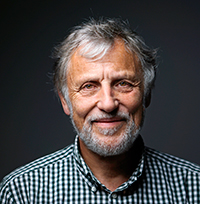 Carsten Gröhn. Bünebüttler Weg 7, 21509 Glinde, Germany. jcgroehn@t-online.de
Carsten Gröhn. Bünebüttler Weg 7, 21509 Glinde, Germany. jcgroehn@t-online.de
Carsten Gröhn was born in Mölln, Schleswig-Holstein, in 1949. He studied biology at the University of Kiel and taught biology at the Gymnasium Glinde for more than 40 years. For 30 years, he has been an enthusiastic collector of amber – his primary interest lies in amber inclusions, especially those in Baltic amber. His aim is to provide amber enthusiasts with comprehensive information. Both his website ambertop.de and the standard reference work ALLES ÜBER BERNSTEIN are widely read in German. Furthermore, he is author and co-author of various other books and publications on amber. As chairman for the Society for the Promotion of the Geological-Paleontological Museum of the University of Hamburg (“Arbeitskreis Bernstein”), he presides over more than 200 amber enthusiasts from around the globe.

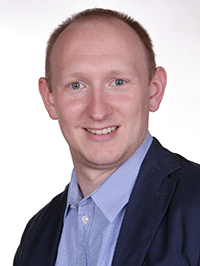 Patrick Müller. Friedhofstr. 9, 66894 Käshofen, Germany. pat14789@web.de
Patrick Müller. Friedhofstr. 9, 66894 Käshofen, Germany. pat14789@web.de
Patrick Müller was born on July 14, 1989 in Zweibrücken (Germany). He studied financial economics and is a passionate private collector of amber inclusions. His collection focus is on amber from Myanmar with about 15,000 amber pieces. More than 100 new species in Myanmar amber from his collection have already been scientifically described. Patrick has to date already been involved in about 30 papers on inclusions in Myanmar amber.

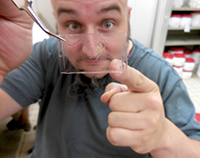 Joachim T. Haug. Ludwig-Maximilians-Universität München, Biocenter, Großhaderner Str. 2, 82152 Planegg-Martinsried, Germany and GeoBio-Center at LMU, Richard-Wagner-Str. 10, 80333 München, Germany. joachim.haug@palaeo-evo-devo.info
Joachim T. Haug. Ludwig-Maximilians-Universität München, Biocenter, Großhaderner Str. 2, 82152 Planegg-Martinsried, Germany and GeoBio-Center at LMU, Richard-Wagner-Str. 10, 80333 München, Germany. joachim.haug@palaeo-evo-devo.info
Joachim T. Haug studied animal ecology (major), sociobiology and palaeontology (minors) at the Julius-Maximilians-Universität Würzburg. After the receipt of the Diplom in 2005, he moved to the work group Biosystematic Documentation at the University of Ulm for his PhD thesis. There he worked on the early crustaceans from the Cambrian 'Orsten', which are preserved three-dimensionally and with minute details. To make the entire morphology clearly visible, Joachim produced computer-based 3D models for each developmental stage of a species, resulting in a 4D model of the species. With 4D models reconstructed for the different species, differences in the developmental pattern between the species became visible. These changes in the developmental timing, so-called heterochronic events must have occurred several times during early crustacean evolution. Due to these findings, Joachim got interested in studying such evolutionary changes of development also in fossils from other deposits and focussed on Palaeo-Evo-Devo (see also http://www.palaeo-evo-devo.info). After his defense in 2009 and two further years as postdoctoral researcher in Ulm, he received two Feodor Lynen research fellowships from the Alexander von Humboldt-Foundation, with which he was doing research at Yale University and at the Ernst-Moritz-Arndt-Universität Greifswald. Besides 3D modelling, Joachim is also interested in different methods of imaging (documentation and presentation). In September 2013, he relocated to the Ludwig-Maximilians-Universität in Munich. In April 2018 Joachim became a Lichtenberg professor at the Ludwig-Maximilians-Universität München (LMU Munich) funded by the Volkswagen Foundation.

